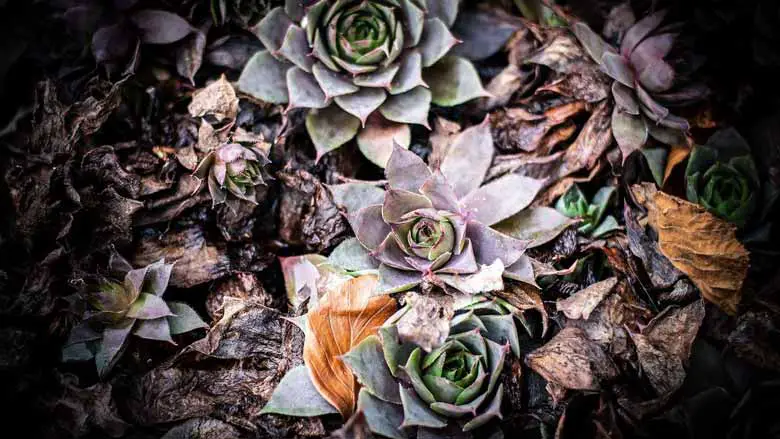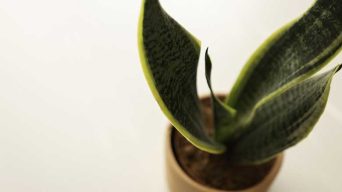If you love succulents, you know they are not the most difficult plants to take care of.
However, sometimes even the toughest plants can show signs of distress.
It is essential to act quickly to save them from dying when this happens.
But how to revive a dying succulent plant?
The good news is that there are many ways to revive a succulent, and most of them are very easy.
This article will discuss the most common problems that can cause succulents to die and how to fix them.
How To Revive an Overwatered Succulent Plant
Excessive watering is a common issue when it comes to caring for succulents.
Succulents store water in their leaves and stem so they can go without water for long periods.
When you water them too often, the plant begins to drown as it can’t absorb more water.
Some common signs that your succulent is overwatered are:
- The leaves are wilted or drooping
- The leaves are soft and squishy
- The stem and leaves are soft and slimy
- Mold or fungus is growing on the leaves
- The succulent leaves start to turn yellow or brown
- The soil is wet and muddy for more than a day or two
If you notice any of these signs, it’s important to take action and revive your plant.
Here are a few tips on how to do that:
- Stop watering your succulent for a week. After a week has passed, water it very lightly.
- Only water your succulents when the soil is completely dry.
- Use a pot with a drainage hole and well-draining soil.
- Place your succulent in a bright, sunny spot.
- Trim off any dead or wilted leaves.
After following these tips, you should see an improvement in your succulent’s health.
How To Save an Underwatered Succulent Plant
Just as succulents can be overwatered, they can also be underwatered.
Succulents flourish in arid environments, so if you’re having trouble getting your succulent to perk up, it could be due to insufficient watering.
Succulents must be watered every week or two, depending on the climate and soil.
Some common signs that your succulent is underwatered are:
- The leaves become wrinkled and shriveled
- The leaves are dry and brittle
- The stem is dry and hard
- There is no moisture in the soil
If you notice any sign of an underwatered succulent, you must take action and revive your succulent.
Here are a few tips on how to do that:
- Add some water to the soil, making sure to wet all of it. If the succulent is in a pot, you can add water until it begins to drain out of the bottom.
- Let the soil dry out before watering again. Succulents don’t like to be constantly wet, so giving them time to dry out between waterings is essential.
- Make sure the succulent is in a location with bright indirect light. Succulents need sunlight, but too much direct sun can scorch their leaves.
- Don’t fertilize the succulent until it begins to perk up. Fertilizing a succulent that is not healthy may do more harm than good.
Succulents are a great addition to any garden, and with a little TLC, you can revive even the most wilted succulent.
Follow these tips, and your succulent will return to its healthy self in no time!
How To Revive a Sunburned Succulent Plant
Succulents love the sun, but too much sun can be harmful.
The best place for a succulent is where it gets plenty of indirect sunlight.
Prolonged exposure to direct sunlight, particularly in the midst of scorching summer conditions, can result in sunburn for succulent plants.
The symptoms of sunburned succulent are:
- The leaves turn brown or black
- The leaves shrivel and dry out
- Brown spots form on the leaves
- The succulent leaves lose their firmness
- The leaves start to fall off
If your succulent is sunburned, the best thing to do is move it to a spot where it will get indirect light.
You can also put a shade cloth over it to protect it from the sun. Avoid direct sunlight until the succulent has healed.
If the succulent leaves are severely brown or black, you can remove them with sharp scissors. Be careful not to damage the stem of the succulent.
If the leaves of your succulents are wilting and dry, you can water it.
Ensure the pot has a drainage hole so the water can drain.
Succulents only need to be watered once a week, and you should only water them when the soil is dry. Be careful not to overwater the succulent.
Apply an Aloe Vera gel to the leaves of a sunburned succulent. Aloe Vera is a natural plant that helps heal sunburns.
Give it some time. Sunburned succulents will usually recover on their own if you give them the proper care.
How To Revive a Frozen Succulent Plant
Most succulents come from semi-arid climates and can tolerate cold weather, but they will not do well if frozen.
Low temperatures can damage the succulent’s cells, and if the plant is frozen for an extended period, it may die.
Succulents are susceptible to frost damage because they lose water to the air through their leaves.
The colder it gets, the more water the plant loses, and if the temperature drops below freezing, the plant can freeze solid.
The symptoms of a frozen succulent are:
- The leaves are wilted and drooping
- The plant is covered in ice crystals
- The stems are brittle and snap when you try to move the plant
- The leaves are brown and dry
If your succulent plant has been frozen, the best thing to do is revive it as soon as possible.
The longer it’s frozen, the less likely it will be to make a full recovery.
Follow these steps to revive your succulent:
- When temperatures drop below freezing, move your succulent plants indoors
- Remove the plant from the cold environment and place it in a warm room
- Move the succulent away from cold windows and drafts
- Trim off any dead or damaged leaves
- If the plant is covered in ice crystals, gently remove them with a hairdryer
- Avoid watering the plant for a few days until it starts to recover
- Once the leaves have unfrozen and started to look healthy, you can begin to water the plant sparingly
- Don’t fertilize the succulent during the recovery process
Succulents are very hardy plants, but they can still die if frozen for a long period.
Be sure to move your succulents indoors when temperatures drop below freezing to prevent them from freezing and dying.
How To Revive a Rotting Succulent Plant
One of the most common problems with succulent plants is rotting.
This can be caused by various things, such as overwatering, underwatering, poor drainage, or too much sunlight.
Root rot is the most common type of rot that affects succulents, and it can be caused by too much water or not enough air.
The symptoms of a rotting succulent are:
- The leaves are wilted and drooping
- The plant is covered in mold or fungus
- The stems are soft and mushy
- The leaves are brown and dry
If your succulent plant is rotting, the best thing to do is to cut off the rotten parts of the plant and discard them.
Be sure to disinfect your pruning shears before you start cutting.
Then, repot the healthy part of the plant in a new pot with fresh soil. Don’t water the plant for a few days until it starts to recover.
Once the plant has recovered, you can start watering it again. Be sure to give it plenty of light and air, and never let the soil become wet and soggy.
Fungus gnats are tiny insects that can cause a succulent to rot.
They are attracted to wet soil, so ensure your plant has proper drainage and does not water it too often.
You can also eliminate fungus gnats by using pesticides or an organic control such as nematodes.
Apply a fungicide to the plant if any fungus or mold is present.
Powdery Mildew is a fungus that can cause succulent plants to rot.
Fungicides that contain sulfur or copper can be used to get rid of Powdery Mildew.
If you follow these steps, your succulent should be able to revive and thrive again.
How To Revive a Droopy Succulent Plant
One of the most common problems with succulent plants is drooping leaves.
This can be caused by various things, such as overwatering, underwatering, or too much sunlight.
The most common reason for drooping leaves is underwatering.
If your succulent plant is drooping, the best thing to do is give it some water.
Be sure to water it thoroughly and let the soil dry before watering again.
If the leaves are drooping because of too much sunlight, you can move the plant to a shadier spot.
Or, you can use a sheer curtain or sun blocker to protect the plant from the sun.
If the leaves are drooping because of overwatering, you must stop watering the plant for a few days until it recovers.
Be sure to give it plenty of light and air during this time.
Succulent plants can also droop due to a lack of nutrients. You can give the plant a diluted fertilizer solution to help it recover.
If the leaves are drooping because of pests, you can treat the plant with a pesticide or insecticidal soap.
Finally, if the leaves are drooping for no apparent reason, you can try repotting the plant in fresh soil.
By following these tips, you can help revive a droopy succulent plant.
How To Revive a Broken Succulent Plant
A broken succulent plant is one reason for a succulent to die. If you’re lucky, the break may only have caused a small amount of damage to the plant.
However, if the break is more severe, it can be difficult to revive the succulent.
Here are the steps to take to revive a broken succulent plant:
- Remove any debris or leaves that may be blocking the wound.
- If the break is more than an inch long, use a moistened cotton swab to clean the area and dry it off with a paper towel.
- Apply a small amount of succulent or cactus potting soil to the wound.
DO NOT water the plant at this point!
Repeat these steps until the plant has healed. It may take several weeks for the succulent to heal completely.
If the plant is not healing, you may need to take more drastic measures.
Cut off the damaged part of the plant and replant it using succulent or cactus potting soil.
DO NOT water the plant for at least two weeks.
After that, you can slowly increase the amount of water you give the plant. Be careful not to overwater it!
How To Save a Succulent Without Roots
If the succulent you’re trying to save has no roots, there’s still hope!
You can try growing the succulent in water or propagating it with stem or leaves cuttings.
Stem Cuttings
To propagate a succulent with stem cuttings:
- Remove a healthy stem from the succulent
- Let the stem dry out for a few days
- Stick the stem into a cactus soil mix
- Keep the soil moist but not wet
- When the stem has rooted, transplant it into a pot
Leaf Cuttings
To propagate a succulent with leaf cuttings:
- Remove a healthy succulent leaf
- Let the leaf dry out for a few days
- Lay the leaf on top of a cactus soil mix
- Keep the soil moist but not wet
- When the leaf has rooted, transplant it into a pot
Water Propagation
If the succulent plant has no roots, you can place it in a glass of water and wait for new roots to grow.
Make sure to change the water regularly, so the plant doesn’t get sick. The process usually takes a few weeks.
If you want to try this method, here are some steps to follow:
- Remove any damaged or dead leaves from the succulent
- Place the succulent in a glass of water
- Change the water every other day
- Wait for new roots to grow
When the succulent has rooted, transplant it into a pot.
Final Thoughts
Succulents are beautiful plants that can add a touch of life to any room or garden.
However, they can be tricky to care for, and sometimes they may die even if you think you are taking good care of them.
If your succulent looks wilted or have brown leaves, don’t give up on it yet!
Knowing the most common problems and how to revive a succulent can help keep your plants healthy and happy.
There are many ways to revive a dying succulent, and you can get your plant back to its former glory with a little effort.







